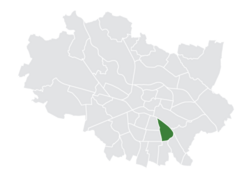Tarnogaj
Tarnogaj
German: Dürrgoy | |
|---|---|
 | |
 Location of Tarnogaj within Wrocław | |
| Country | |
| Voivodeship | Lower Silesian |
| County/City | Wrocław |
| Incorporated into the city | 1904 |
| Established the modern-day district | 1991 |
| Population (2022) | |
| • Total | 9,108 |
| [1] | |
| Time zone | UTC+1 (CET) |
| • Summer (DST) | UTC+2 (CEST) |
| Area code | +48 71 |
| Website | Osiedle Tarnogaj |
Tarnogaj (Polish pronunciation: [tarˈnɔgaj], German: Dürrgoy, [ˈdʏɐ̯gɔɪ̯]) is a district in Wrocław located in the central part of the city. It was established in the territory of the former Krzyki district.
Initially a village, the settlement was incorporated into Breslau (Wrocław) in 1904.[2]
Name
According to German linguist Heinrich Adamy, the name of the village derives from the Polish word 'gaj' ('grove'). In his work on local names in Silesia, published in 1888 in Breslau, he mentions Gay as the oldest name of the locality, giving its meaning as "trockenes Wäldchen" ("little, dry forest"). The original name was later phonetically Germanized by the Germans to Dürrgoy, losing its original meaning.[2]
The settlement was mentioned by the names Gay (1311), Gaya (1316), Gay (1320, 1374), Dirngay (1579), Dürgay (1638), Dirgai (1669), and Dürrgoy (1904). In 1945, following the war, its name was briefly changed to Cierniogaj. Since 1948, it has been known as Tarnogaj.[2]
History
The earliest records of the settlement can be traced back to 1288.[3] The village has a history of ownership, dating back to 1336 when it was received by Jan of Głogów from Margaret, the widow of Peter of Głogów. Over the years, it changed hands and was eventually owned by the Wrocław missionaries from the Holy Cross from 1385 until secularization in 1810.[2]
By 1845, its population had grown to 230. During this time, the village thrived, with 144 residents engaged in growing vegetables for Breslau, and living in 21 houses. The Lower Silesian District Gasworks, located in Dürrgoy, has been in operation since the early 1900s to supply the city.[2]
To the south of the district a housing complex was built in 1919 for the employees of the gas plant. The complex covers an area of 11 hectares and is rectangular in shape, divided by three parallel streets. The designers aimed to create the appearance of a colony of single-family houses with gardens, surrounded by a screen of taller buildings.[3]
In March 1933, a concentration camp known as KZ Dürrgoy was established in the district by the Nazis for political prisoners. It was closed later that same year.[2]
During the siege of Breslau in 1945, the mill that had been present since the Middle Ages was destroyed due to the intense fighting in the area, which caused significant damage.[2]
In 1991, after reforms in the administrative division of Wrocław, Tarnogaj became one of the city's 48 districts.[4]
As a result of the significant war damage, the district is undergoing a process of modernization, which includes the construction of contemporary multi-family apartment blocks in addition to the original settlements. A significant portion of the district is railroad land.[3]
References
- ^ "Liczba mieszkańców zameldowanych we Wrocławiu w podziale na Osiedla – stan na 31 grudnia 2022 r."
- ^ a b c d e f g "Historia Tarnogaju". osiedle.wroc.pl. Retrieved 2024-01-11.
- ^ a b c "Tarnogaj". Bezpartyjny Wrocław (in Polish). Retrieved 2024-01-11.
- ^ "UCHWAŁA NR XX/110/91 RADY MIEJSKIEJ WROCŁAWIA z dnia 20 marca 1991 roku w sprawie podziału Wrocławia na osiedla".
- CS1 Polish-language sources (pl)
- Articles with short description
- Short description matches Wikidata
- Use American English from January 2024
- All Wikipedia articles written in American English
- Short description is different from Wikidata
- Articles containing German-language text
- Pages using infobox settlement with no coordinates
- Pages with Polish IPA
- Pages with German IPA
- Districts of Wrocław